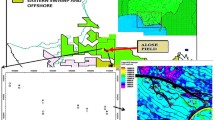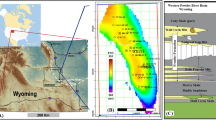Abstract
Seismic inversion, complemented by machine learning algorithms, significantly improves the accuracy and efficiency of subsurface parameter estimation from seismic data. In this comprehensive study, a comparative analysis of machine learning techniques is conducted to predict subsurface parameters within the inter-well region. The objective involves employing three separate machine learning algorithms namely Probabilistic Neural Network (PNN), multilayer feedforward neural network (MLFNN), and Radial Basis Function Neural Network (RBFNN). The study commences by generating synthetic data, which is then subjected to machine learning techniques for inversion into subsurface parameters. The results unveil exceptionally detailed subsurface information across various methods. Subsequently, these algorithms are applied to real data from the Blackfoot field in Canada to predict porosity, density, and P-wave velocity within the inter-well region. The inverted results exhibit a remarkable alignment with well-log parameters, achieving an average correlation of 0.75, 0.77, and 0.86 for MLFNN, RBFNN, and PNN algorithms, respectively. The inverted volumes portray a consistent pattern of impedance variations spanning 7000–18000 m/s*g/cc, porosity ranging from 5 to 20%, and density within the range of 1.9–2.9 g/cc across the region. Importantly, all these methods yield mutually corroborative results, with PNN displaying a slight edge in estimation precision. Additionally, the interpretation of the inverted findings highlights anomalous zones characterized by low impedance, low density, and high porosity, seamlessly aligning with well-log data and being identified as sand channel. This study underscores the potential for seismic inversion, driven by machine learning techniques, to swiftly and cost-effectively determine critical subsurface parameters like acoustic impedance and porosity.


















Similar content being viewed by others
Data availability
Contact the corresponding author by email (mauryasatya@bhu.ac.in) at any time, please.
References
Ahmed N, Wiktor WW, Dario G (2022) Constrained non-linear AVO inversion based on the adjoint-state optimization. Comput Geosci 168:105214
Ahmed N, Wiktor WW, Dario G, Tuhin B (2023) Constrained non-linear AVO inversion for dynamic reservoir changes estimation from time-lapse seismic data. Geophysics 89(1):1–65
Alpaydin (2021) Ethem. Machine learning. Mit Press
Anifowose FA, Jane L, Abdulazeez A (2017) Ensemble machine learning: an untapped modeling paradigm for petroleum reservoir characterization. J Pet Sci Eng 151:480–487
Artun E, Mohaghegh SD, Toro J, Wilson T, Sanchez A (2005) Reservoir characterization using intelligent seismic inversion. In: Proceedings of the SPE Eastern Regional Meeting, Morgantown, pp 14–16
Baddari K, Tahar A, Noureddine D, Jalal F (2009) Application of a radial basis function artificial neural network to seismic data inversion. Comput Geosci 12:2338–2344
Banerjee A, Rima C (2022) Mapping of reservoir properties using model-based seismic inversion and neural network architecture in Raniganj basin, India. J Geol Soc India 4:479–486
Bhatt A, Helle HB (2002) Committee neural networks for porosity and permeability prediction from well logs. Geophys Prospect 50(6):645–660
Chaki S (2015) Reservoir characterization: A machine learning approach, MS Thesis, Indian Institute of Technology, India, 98p
Choi RY, Coyner AS, Jayashree KC, Chiang MF, Campbell JP (2020) Introduction to machine learning, neural networks, and deep learning. Transl Vis Sci Technol 2:14-14
Dufour J, Squires J, Goodway WN, Edmunds A, Shook I (2002) Case History: Integrated geological and geophysical interpretation case study, and Lamé rock parameter extractions using AVO analysis on the Blackfoot 3C-3D seismic data, southern Alberta, Canada. Geophysics 67(1):27–37
Ecoublet P, Symes W (1998) Application of probabilistic neural network to porosity prediction. In: The rice inversion project, annual report. Rice University, Houston, TX
El Naqa I, Murphy MJ (2015) What is machine learning? Springer International Publishing
El-Dabaa SA, Farouk IM, Ahmed TA, Alhussein AB (2022) Prediction of porosity and water saturation using a probabilistic neural network for the Bahariya Formation, Nader Field, north western desert. Egypt J African Earth Sci 196:104638
Feng R (2020) Estimation of reservoir porosity based on seismic inversion results using deep learning methods. J Nat Gas Sci Eng 77:103270
Gao Z, Chuang L, Tao Y, Zhibin P, Jinghuai G, Zongben X (2020) OMMDE-Net: A deep learning-based global optimization method for seismic inversion. IEEE Geosci Remote Sens Lett 18:208–212
Gogoi T, Rima C (2019) Estimation of petrophysical parameters using seismic inversion and neural network modeling in Upper Assam basin. India Geosci Front 10:1113–1124
Hampson D, Todor T, Brian R (2000) Using multi-attribute transforms to predict log properties from seismic data. Explor Geophys 31:481–487
Hampson DP, Schuelke JS, Quirein JA (2001) Use of multi-attribute transforms to predict log properties from seismic data. Geophysics 66(1):220–236
Haris A, Sitorus RJ, Agus R (2017) Pore pressure prediction using probabilistic neural network: a case study of South Sumatra Basin. In: IOP Conference Series: Environ Earth Scivol. 62:012021
Herrera VM, Brian R, Adilce F (2006) Neural networks in reservoir characterization. Lead Edge 25:402–411
Hou Q, Jianwei Z, Bo L (2016) Estimation of reservoir porosity using probabilistic neural network and seismic attributes. Glob Geol 19:6–12
Jeong C, Mukerji T, Mariethoz G (2017) A fast approximation for seismic inverse modeling: Adaptive spatial resampling. Math Geosci 49:845–869
Jordan MI, Tom MM (2015) Machine learning: trends, perspectives, and prospects. Science 6245:255–260
Kim Y, Nakata N (2018) Geophysical inversion versus machine learning in inverse problems. Lead Edge 37(12):894–901
Kushwaha PK, Maurya SP, Piyush R, Singh NP (2020) Porosity prediction from offshore seismic data of F3 Block, the Netherlands using multi-layer feed-forward neural network. Curr Sci 10:1652
Kushwaha PK, Maurya SP, Piyush R, Singh NP (2021) Estimation of subsurface rock properties from seismic inversion and geo-statistical methods over F3-block, Netherland. Explor Geophys 52:258–272
Lawton DC, Robert RS, Andreas C, Stacey H (1995) Advances in 3C–3D design for converted waves. CREWES Res Rep 7:43–51
Lawton DC, Stewart R, Cordsen A, Hrycak S (1996) Design review of the Blackfoot 3C-3D seismic program. The CREWES Project Research Report 8(38):1
Leite EP, Vidal (2011) 3D porosity prediction from seismic inversion and neural networks. Comput Geosci 8:1174–1180
Li M, Yan XS, Zhang MZ (2023) A comprehensive review of seismic inversion based on neural networks. Earth Sci Inform 1–31
Liu X, Qiang G, Xiaohong C, Li J, Yangkang C (2021) Extreme learning machine for multivariate reservoir characterization. J Pet Sci Eng 205:108869
Mahmood MF, Ahmad Z (2017) Application of multi-layer feed forward neural network (MLFNN) for the. Nucleus 1:10–15
Mahmood MF, Shakir U, Abuzar MK, Khan MA, Khattak N, Hussain HS, Tahir AR (2017) Probabilistic neural network approach for porosity prediction in Balkassar area: a case study. J Himal Earth Sci 50(1):111
Maurya SP, Singh KH (2015) Reservoir characterization using model-based inversion and probabilistic neural network. Discovery 228:122–127
Maurya SP, Singh NP (2018) Application of LP and ML sparse spike inversion with probabilistic neural network to classify reservoir facies distribution-A case study from the Blackfoot field, Canada. J Appl Geophy 159:511–521
Maurya SP, Sarkar P (2016) Comparison of post stack seismic inversion methods: a case study from Blackfoot field, Canada. Int J Eng Res 7(8):1091–1101
Maurya SP, Singh N P, Kumar H S (2020) Seismic inversion methods: a practical approach, vol 1. Springer, Cham, Switzerland
Misra S, Satinder C, John Z (2010) Neural network regression analysis and post-stack inversion-A comparison. SEG Technical Program Expanded Abstracts 2010, pp 1473–1477. Society of Exploration Geophysicists
Mukherjee B, Kalachand S (2019) Prediction of reservoir parameters in gas hydrate sediments using artificial intelligence (AI): a case study in Krishna-Godavari basin (NGHP Exp-02). J Earth Syst Sci 128:1–14
Qiang Z, Qamar Y, Naser G, Qizhen D (2020) Prediction of reservoir quality from log-core and seismic inversion analysis with an artificial neural network: a case study from the Sawan Gas Field Pakistan. Energies 2:486
Quiñones AE, Leimar O, Lotem A, Bshary R (2020) Reinforcement learning theory reveals the cognitive requirements for solving the cleaner fish market task. Am Nat 195(4):664–677
Raknes EB, Børge A, Wiktor W (2015) Three-dimensional elastic full waveform inversion using seismic data from the Sleipner area. Geophys J Int 202:1877–1894
Röth G, Albert T (1994) Neural networks and inversion of seismic data. J Geophys Res Solid 99:6753–6768
Russell BH, Laurence RL, Daniel PH (2003) Application of the radial basis function neural network to the prediction of log properties from seismic attributes. Explor Geophys 34:15–23
Russell BH (2004).The application of multivariate statistics and neural networks to the prediction of reservoir parameters using seismic attributes. PhD Thesis, Department of Geology and Geophysics, Calgary, Alberta
Russell BH (2019) Machine learning and geophysical inversion—A numerical study. Lead Edge 38:512–519
Sayers C, Chopra S (2009) Introduction to this special section: Seismic modeling. Lead Edge 28(5):528–529
Schuster GT (2017) Seismic inversion Society of Exploration Geophysicists
Sen MK, Stoffa PL (1991) Nonlinear one-dimensional seismic waveform inversion using simulated annealing. Geophysics 56(10):1624–1638
Sen MK (2006) Seismic inversion. Society of Petroleum Engineers, Richardson TX
Shuaib MEK, Berguig MC (2022) Thin-bed reservoir characterization by integration of seismic inversion, multi attributes analysis, and neural network: a case study in the Sufyan oil field of the Muglad rift basin, Sudan. Bull Geophys Oceanogr 63:455–480
Taheri M, Ali AC, Ramin N, Ali K (2021) Modeling of the shale volume in the Hendijan oil field using seismic attributes and artificial neural networks. Acta Geol Sin-Engl 95:1322–1331
Yasin Q, Mariusz M, Ghulam MS, Hung VT (2022) Fault and fracture network characterization using seismic data: a study based on neural network models assessment. Geomech Geophys Geo-Energy Geo-Resour 8:41
Zhang Y, Xueyu Z, Jinghuai G (2023) Seismic inversion based on acoustic wave equations using physics-informed neural network. IEEE Trans Geosci Remote Sens 61:1–11
Acknowledgements
The authors extend their gratitude to CGG Geo software for generously providing the Hampson Russell software and data, which greatly contributed to this research. In addition, the authors would like to express sincere appreciation to the funding agencies UGC-BSR (M-14-0585) and IoE BHU (Dev. Scheme no. 6031B) for their invaluable financial support, which made this study possible. Special thanks are also due to www.mathworks.com and www.norsar.no for granting academic licenses for Matlab (2022b) and Norsar (complete package), respectively. These vital resources played a pivotal role in the successful completion of this work.
Funding
The work is funded by the University Grant Commission, Govt. of India (M-14-0585), and Institute of Eminence, Banaras Hindu University (Dev. Scheme no. 6031B).
Author information
Authors and Affiliations
Contributions
Nitin Verma is responsible for the experiment process and article writing. S.P. Maurya is responsible for experimental guidance and data collection. Ravi Kant, Raghav Singh, and A.P. Singh are responsible for literature research. K.H. Singh and M.K. Srivastava are responsible for guiding the article format. G. Hema, P.K. Kushwaha, Alok K. Tiwari, and Richa are responsible for the preparation of figures and finalizing manuscripts.
Corresponding author
Ethics declarations
Competing interests
The authors declare no competing interests.
Additional information
Communicated by: H. Babaie
Publisher's Note
Springer Nature remains neutral with regard to jurisdictional claims in published maps and institutional affiliations.
Rights and permissions
Springer Nature or its licensor (e.g. a society or other partner) holds exclusive rights to this article under a publishing agreement with the author(s) or other rightsholder(s); author self-archiving of the accepted manuscript version of this article is solely governed by the terms of such publishing agreement and applicable law.
About this article
Cite this article
Verma, N., Maurya, S.P., kant, R. et al. Comparison of neural networks techniques to predict subsurface parameters based on seismic inversion: a machine learning approach. Earth Sci Inform 17, 1031–1052 (2024). https://doi.org/10.1007/s12145-023-01199-x
Received:
Accepted:
Published:
Issue Date:
DOI: https://doi.org/10.1007/s12145-023-01199-x




